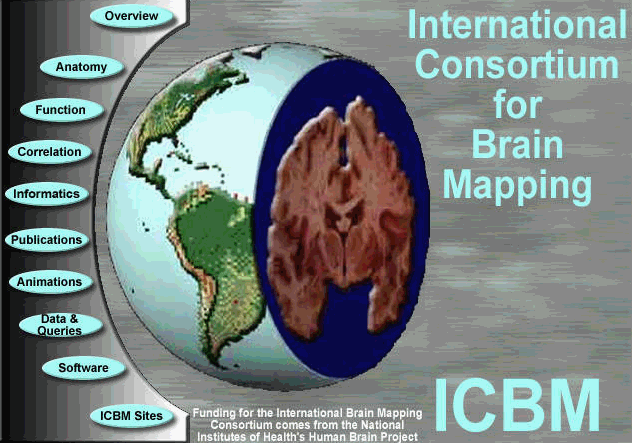Four-Dimensional Probabilistic Atlas of the Human Brain
Journal of the American Medical Informatics Association [submitted, June 2000]
John
Mazziotta1, Arthur Toga2, Alan Evans3, Peter
Fox4, Jack Lancaster4, Karl Zilles5,11,
Roger
Woods1, Tomas Paus3, Gregory Simpson6, Bruce
Pike3, Colin Holmes2, Louis Collins3,
Paul
Thompson 2, David MacDonald3, Marco Iacoboni1,
Thorsten Schormann5,
Katrin
Amunts11, Nicola Palomero-Gallagher11, Stefan Geyer5,
Larry Parsons4,
Katherine
Narr2, Noor Kabani3, Georges Le Goualher3,
Dorret Boomsma8,
Tyrone
Cannon7, Ryuta Kawashima10, Bernard Mazoyer9
INTERNATIONAL CONSORTIUM FOR BRAIN MAPPING (ICBM)
1. Brain Mapping Center, UCLA School of Medicine, Los Angeles, CA
2. Laboratory of Neuroimaging, UCLA School of Medicine, Los Angeles, CA
3. Montreal Neurologic Institute, McGill University, Montreal, Canada
4. Research Imaging Laboratory, University of Texas at San Antonio
5. Heinrich Heine University, Düsseldorf, Germany
6. Department of Radiology, University of California at San Francisco
7. Department of Psychology, UCLA, Los Angeles, CA
8. Vrije University, Amsterdam, The Netherlands
9. University de Caen, Caen, France
10. Tohoku University, Sendai, Japan
11. Institute of Medicine, Research Center Jülich, Germany

Abstract:
We describe the development of a four-dimensional atlas and reference system that includes both macroscopic and microscopic information on structure and function for the human brain between the ages of eighteen and ninety. Given the presumed large but previously unquantified degree of structural and functional variance among normal individuals in the human population, the basis for this atlas and reference system is probabilistic. Through the efforts of an International Consortium for Brain Mapping (ICBM) 7,000 subjects will be included in the initial phase of the database and atlas. Each subject will have detailed demographic, clinical, behavioral and imaging information collected. In addition, 5,800 subjects will contribute DNA for the purpose of conducting genotype-phenotype-behavioral correlations. The process of developing the strategies, algorithms, data collection methods, validation approaches, database structures and distribution of results is described in this report. Examples of applications of the approach are described for the normal brain in both adults and children as well as in patients with schizophrenia. This project should provide new insights into the relationship between microscopic and macroscopic structure and function in the human brain and have important implications in basic neuroscience, clinical diagnostics and cerebral disorders.
Key Words: atlas, probabilistic, four-dimensional, cytoarchitecture, chemoarchitecture, magnetic resonance imaging, database, segmentation, brain mapping, neuroanatomy, genetics, schizophrenia